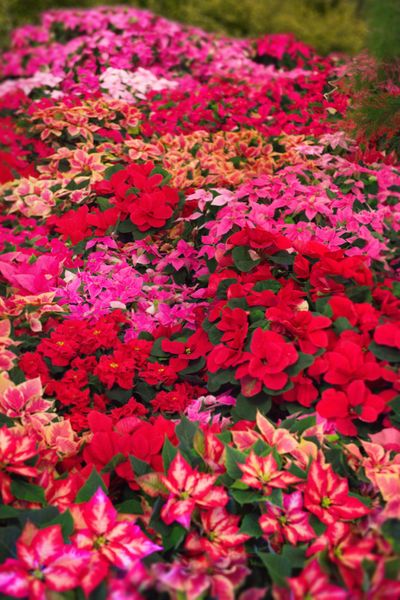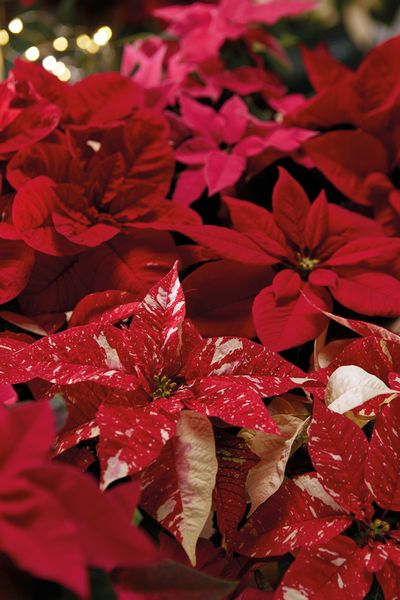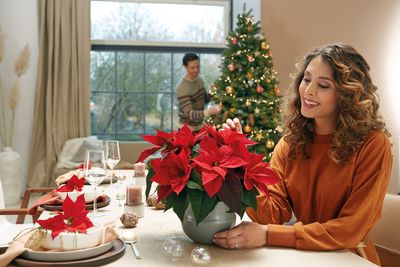How do they do it? Poinsettia growers reveal secrets to beautiful coloured bracts in time for Christmas
Published:
Read Time: 4 mins
It’s the most wonderful time of the year… no other celebration creates such a sense of holiday at home as Christmas. And for households across the UK, the festive season simply wouldn’t be complete without a gorgeous poinsettia gracing their living room. These iconic symbols of Christmas are arriving at stores nationwide by the lorry load and are guaranteed to fly off shelves – but how do growers ensure that plants are topped with beautiful coloured bracts at precisely the right time?
Whether your poinsettia is sporting traditional Christmassy red, icy white shades, delicate tones of pink or contemporary marbled bicolour hues, these awe-inspiring colours are the result of precision growing by professionals – a sophisticated operation that has been honed over the years to run like a well-oiled machine, ensuring that the upper rosettes of poinsettias’ leaves transform from green to shades of vibrant colours in the run-up to the festive season.
Creating this splash of cosy Christmas colour every December is one of growers’ best-kept secrets, but now, Stars for Europe, the leading poinsettia marketing group, is providing an insight into how the professionals achieve such a formidable crop against all odds every winter.
Poinsettias are plants that are defined as photoperiodic. Put simply, they respond to natural changes in varying lengths of daylight and darkness, the result being wonderfully coloured bracts initiated by winter’s shorter days and lower light levels. To ensure perfect colouring ahead of the festive season, plants are restricted to less than 12 hours of daylight, with growers plunging poinsettias into darkness by excluding all sources of light for the remainder of each 24-hour period.
The specialist skill doesn’t end there! To arrive at stores in tip-top condition, plants growing at commercial nurseries need to be kept snug, at constant temperatures of around 18°C, which helps poinsettias to colour-up nicely. Growers also use specialist techniques to carefully regulate the height of plants destined for store shelves: this keeps poinsettias neat and compact, whereas plants growing in their native environments would reach for the skies.
With professional growers doing all the hard work to ensure that perfect poinsettias grace store shelves in the run-up to Christmas, it’s important to know how to spot a healthy plant that’ll provide months of joy and colour – and how to keep it at its prime. Follow this five-point guide from the experts at Stars for Europe to ensure you choose a bloomin’ marvellous poinsettia that’ll form the centrepiece of your festive display.
1) Poinsettias relish warm winter environments, so choose plants at their prime located well inside stores, rather any positioned near chilly store entrances, as poinsettias dislike cold draughts.
2) Look for plants with rich, even green leaves and vibrantly coloured bracts. A healthy poinsettia shouldn’t show signs of leaf yellowing or leaf drop, so choose carefully.
3) Ask the checkout operator to wrap the plant in paper so it can be kept snug on the journey home. Never leave poinsettias in a freezing car while you head off to do other Christmas shopping, as plants dislike sudden plunges in temperature and can sulk if exposed to winter cold.
4) Christmas cards dropping through letterboxes are likely to depict red-topped poinsettias sat next to a fireplace in idyllic festive displays. In fact, blazing heat is the worst possible environment – Christmassy as it may look, it’s best to site poinsettias away from open fires, log burners and radiators. To keep poinsettias healthy, choose a warm, bright, well-lit position – filtered light is preferential to direct sunlight, and in a spot that’s free from cold draughts. Plants will reward you with a longer lasting display if temperatures aren’t allowed to drop lower than 13°C.
5) Poinsettias are easy to grow and maintain, but overwatering is the biggest mistake that owners commonly make. Watering sparingly is the key to success: only water when the surface of the compost has almost dried out. Don’t leave poinsettias with their pots sat in saucers of water, as plants left in saturated compost are at increased risk of outbreaks of grey mould.
Find out more
To find out more about Stars for Europe, and to access its incredible library of advice, aspirational imagery and content please visit https://www.starsuniteeurope.eu/en/
NOTES TO EDITORS
Stars for Europe
Stars for Europe (SfE) is a marketing initiative founded by European poinsettia breeders Dümmen Orange, Selecta One, Beekenkamp and Syngenta Flowers, supported by MNP Flowers. The initiative began in 2000 with the aim to promote and secure long-term poinsettia sales in Europe. SfE activities are currently taking place in 22 European nations.
Press contact
Stars for Europe UK press office
Hornby Whitefoot PR
Phon: 07851 610573
Mail: kimberley@hornbywhitefootpr.co.uk
Ends
Editors notes
Stars for Europe (SfE) is a marketing initiative founded by European poinsettia breeders Dümmen Orange, Selecta One, Beekenkamp and Syngenta Flowers, supported by MNP Flowers. The initiative began in 2000 with the aim to promote and secure long-term poinsettia sales in Europe. SfE activities are currently taking place in 22 European nations.





